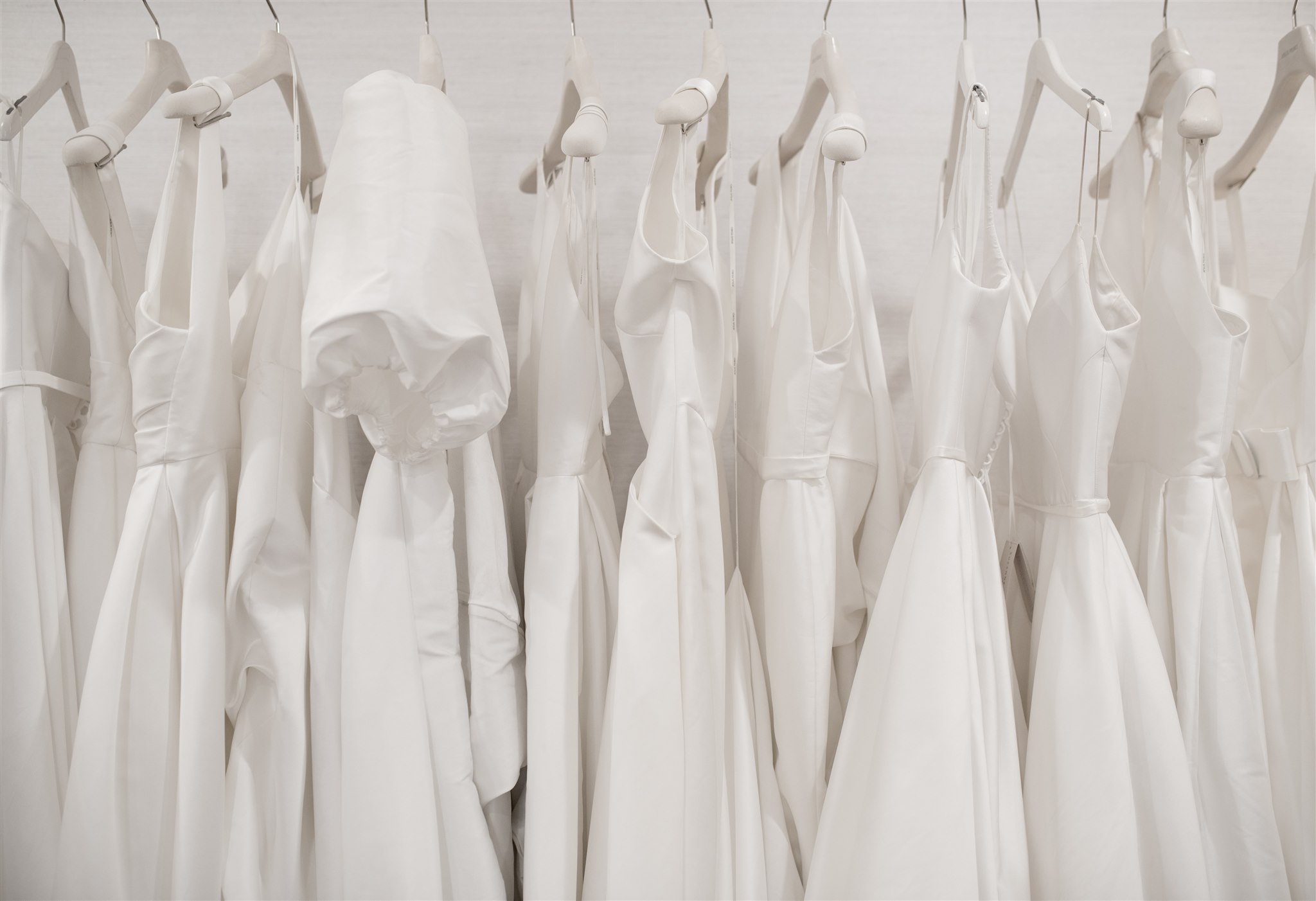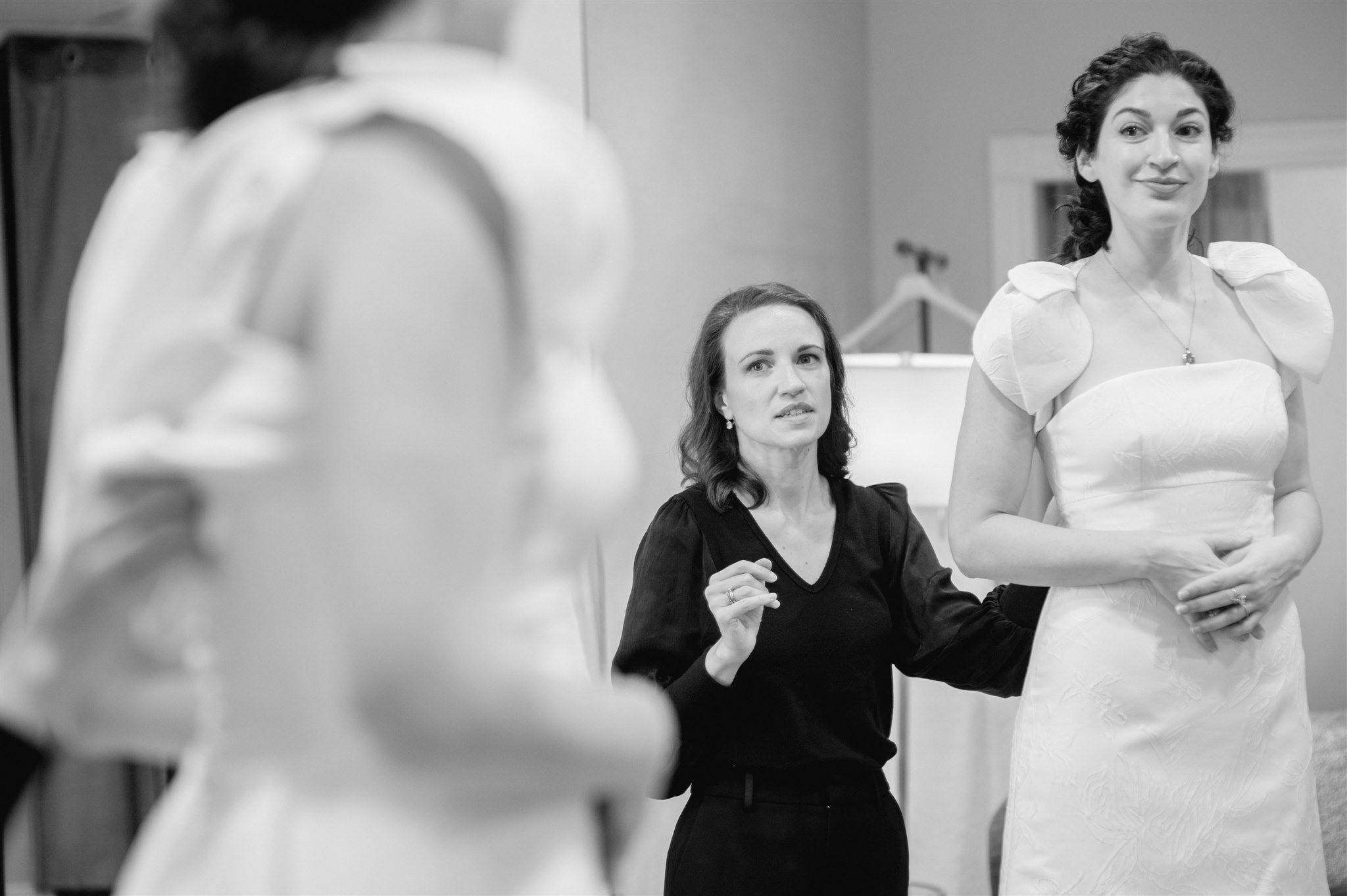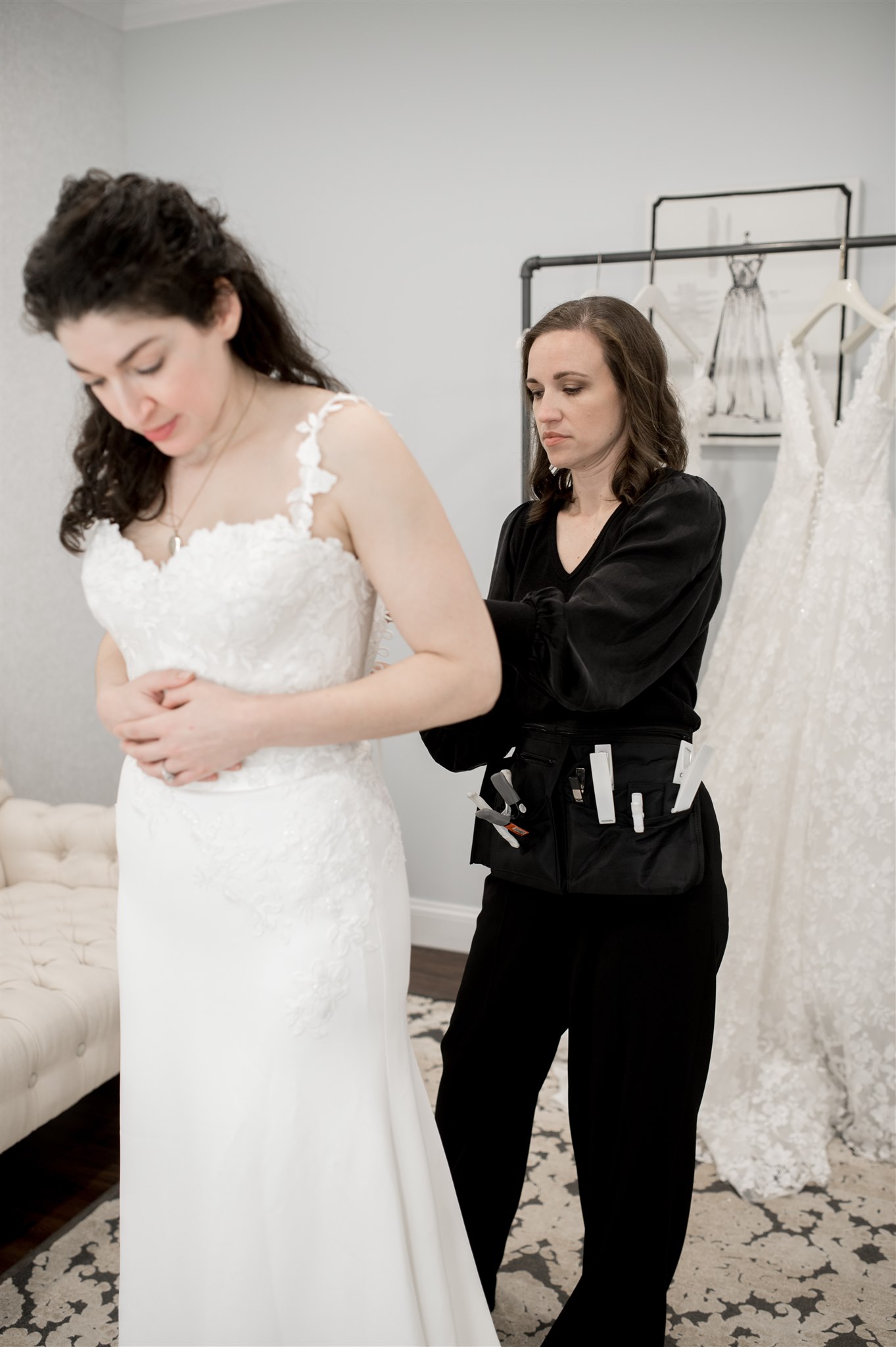Confused by Bridal Sizing
The last thing you want to be worried about on your wedding day is if the dress fits. Your wedding day is going to be one of the most special memories that you will have and wedding gowns can be costly, so it makes sense to be concerned about how the dress fits. In this blog post, we will talk about wedding dress sizing so that you will be ready for your special day.
Here are the topics we will cover that will help you when you shop for wedding dresses:
- Bridal dress sizing
- About wedding dress alterations
- How to have the best wedding dress alterations
- Timeline for wedding dress alterations

Confused by Bridal Sizing? Here’s What You Need to Know.
Going wedding dress shopping can be fun or stressful depending on your research when it comes to planning your wedding. Bridal gown sizing is often a hot topic when brides shop for their wedding gowns. It can be a bit confusing, so I’m going to break it down for you.
Why Wedding Dresses Run So Small
Nowadays, the size of your clothes can be hard to deal with, especially if you are wanting to lose weight. What you have to remember is that size does not define you, especially with bridal sizing. Many brides will go on a diet just for their wedding dress and their wedding day (but they don’t have to!). Thus, it is important to realize that bridal sizing just simply does not make sense.
Bridal sizing runs smaller than typical street sizing, it’s true. But it’s not because designers want to confuse you or make you feel insecure.
Bridal sizing is actually based on traditional European sizing from the 1940s. Ready-to-wear sizing in the U.S was adjusted over the years, but bridal dresses have remained true to original size charts. That is why, for the most part, bridal sizing runs two sizes smaller than ready-to-wear (what you would buy when you are shopping in Nordstrom, for example).
To add to the confusion, every bridal designer uses a different size chart based on their own patterns. Some designers can run smaller or bigger than others.
The cut of the dress can affect the size as well. For example, let’s say a bride has a larger hip than bust line and wants a gown with a full skirt. That bride could order a smaller size to fit her better in the bust and waist.
To put it more clearly, your wedding dress (especially if it is a designer wedding dress) will most likely not be the same size that you normally wear.
The bride’s hip measurements may not matter as much with a full skirt wedding dress style. Or if it’s a fitted dress, then the bride must order to the largest measurement taken and have the dress alerted altered throughout to get a better fit. Remember, choosing a cut that shows off your favorite features is a great way to feel more comfortable and confident!
When taking wedding dress measurements, we recommend you have someone assist you, and ideally, have it done by a stylist at a bridal store. Contact us if you would like to have your bridal measurements done accurately in our store. We are located just outside Boston!

Sizing is Just a Number
Some brides are confused by the shopping experience, especially if they’re browsing sample sales or shops without the help of a bridal expert. If you are shopping at a trunk show – remember that those sample sizes are typically the smaller size.
What is a wedding dress trunk show? A bridal trunk show is a special event that features a wedding dress designer (a rep or stylist) and an entire line of new wedding dresses are featured during a set time (several days). We do this at Your Dream Bridal as well. You can learn about our upcoming designer trunk shows here.
Some brides can also get frustrated by the sizing, but I try to remind my brides, that it is just a number. Your measurements are what matter. It’s about finding the ideal fit.
Focus on the customization aspect: especially if you are getting a wedding dress made to measure, you are getting a custom dress, specially made for you. That should make you glow all the more on your special wedding day as you walk down the aisle and treasure those moments with your partner and dear friends and family.
Wedding Dress Measurements: What to Expect
Because all of the gowns I carry at Dream are made-to-measure, we don’t have to worry as much about naming a single “size” for your gown. We’ll take your measurements, and then the fabric will be cut and sewn according to your body. Made-to-measure dresses cost more than the more common made-to-order gowns you’ll see at many larger bridal shops, but because they are created to fit your unique body shape, they typically will fit you much better to your shape and proportion.
Made-to-Measure measures more than your bust, waist, and lower hip. It takes into account your higher hip, underbust, cup size, shoulder to waist, nape to the waist as well as waist to hem. This is great for brides who have a large bust, no bust, petite (shorter than 5’4″) or tall (taller than 5’6″), short-waisted or long-waisted. And typically we can also at this point adjust a neckline, skirt shape, or even fabric change to make the dress fit and look what a bride always wanted.
Be sure to wear full-coverage nude underwear and a well-fitted bra with straps to make trying on dresses and taking measurements easier and more comfortable. Because of hem measurement, it also helps to bring a pair of heels in a heel height you plan to wear on your wedding day.
Thanks to Dream’s totally private appointments (the salon is closed to everyone but you and your guests), you don’t need to stress about getting measured in front of strangers!

Wedding Dress Alteration Tips for an Incredible Fit
And an excellent tailor will also be your best friend. Alterations are almost always necessary, and an expert seamstress or seamster can turn your dress into a perfect-fitting gown. On average, a bride should expect to spend $500 to $1000 on wedding dress alterations depending on the fabric and fit. And alterations are typically done outside of the bridal shop.
You definitely want to choose someone specializing in bridal and book an appointment in advance, as soon as you have ordered your dress and wedding date set.
Ideally, your dress will fit just right on a made-to-measure gown—particularly if you have chosen to do some customization with the help of your bridal stylist and the designer.
That being said, all gowns need at least some minor tweaks for a dream fit. Common alterations for made-to-measure gowns include adding in bra cups, adjusting strap lengths, creating a bustle, and hem as long as you have stayed the same as when measured at your first appointment.
At Dream, I do my best to accommodate brides with dresses that work for every shape and size. I believe it is essential for brides to see the fit of the gown and feel good while they do it! Most of my dresses are a bridal size 10 or 12, which would be sizes 8 or 10 in street (aka ready-to-wear) sizing. I do, at times, have gowns in a size 8 or size 14 as well. You can browse my current gown selection here.
Wedding Dress Alteration Timeline
To break this down further, it is important to have realistic expectations for your wedding dress, especially if it is a designer dress and you want the alterations to be done accurately and beautifully.
Suggested Time to Purchase Your Dress: 10-11 Months Beforehand
If possible, focus on finding and purchasing your wedding gown 10-11 months before your set wedding date. If you have your heart set on a designer wedding dress, this is the ideal time we suggest. The world is ever-changing though and this is just a guideline. The most important thing to remember is to only start shopping for your wedding dress when you are actually ready to buy. You have a budget set and are ready to commit. Over-shopping is stressful and overwhelming and can lead to wedding dress regret. So it’s never too early to start shopping or to say yes as long as you’re ready.
Time Suggested for Alterations: 3-4 Months Before the Date
Especially if you are planning to get married during a busier time of the year for your wedding, have a realistic timeframe for how long it will take to get it just right. Wedding dress alterations usually take several fittings as well, so this time frame helps you prepare with low stress!
Less confused about bridal sizing? I hope so. If you still have questions, let me know. I look forward to helping you find a gown that fits like a dream.
Conclusion:
In this blog post, we covered all you need to know regarding wedding dress sizing when you go shopping for your beautiful wedding gown for your special day.
Here’s the summary:
- Bridal Dress Sizing: It has been traditionally smaller because they have remained true to European sizing from the 1940s. At the end of the day, expect to have your dress size at least one or two sizes larger than the normal clothing size that you wear.
- Wedding Dress Alterations: these can vary because everybody’s body is different. It takes into account your higher hip, underbust, cup size, shoulder to waist, nape to the waist as well as waist to hem.
- How to Have the Best Wedding Dress Alterations: you’ll want to find a tailor you can trust and someone that can truly make all the right adjustments to achieve the perfect fit.
- Timeline for Wedding Dress Alterations: The timeline can vary, especially if you have purchased a designer wedding dress. Search for a dress 12 months before your date and give it 3-4 months for all the alterations to be finalized.
Ready to start your wedding dress search or looking for beautiful designer wedding dress inspiration? We are proud to be a premier Bridal Boutique in the Greater Boston area. Check out all of our featured gowns and reach out to us if you would like to book an appointment!